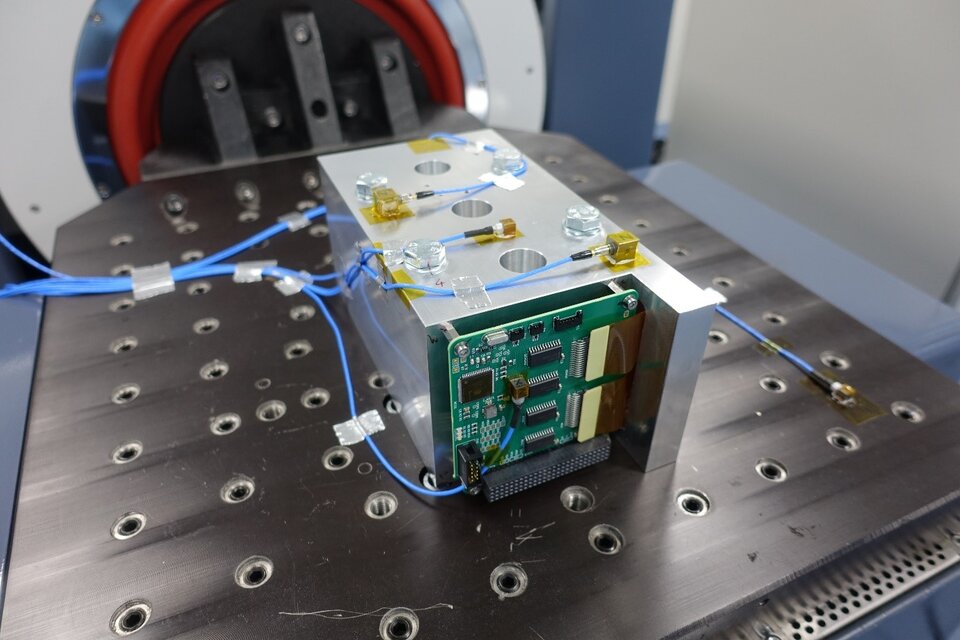AlbaSat Impact Sensor completes the environmental test campaign
The AlbaSat team participating in ESA Academy’s Fly Your Satellite! Design Booster programme has just completed an environmental test campaign of one of their payloads in the CubeSat Support Facility (CSF) in ESEC, Belgium. With this achievement, the students have made one further step towards the flight model.

The AlbaSat mission has four objectives:
- collect in-situ measurements of the sub-mm space debris environment in LEO;
- study the micro-vibration environment on the satellite throughout different mission phases;
- do orbit and attitude determination through laser ranging;
- investigate alternative systems for possible Satellite Quantum Communication applications on nanosatellites.
The team from the University of Padova, Italy, is developing a 2U CubeSat with four in-house developed payloads: an impact sensor, a micro-vibration sensor, Corner Cube Retroreflector and a Modulating Retro Reflector. To reach their first objective, the team is developing an in-situ impact sensor that will compute the number of space debris impacting the spacecraft.
An environmental test campaign is a key milestone in the development of new products. To reduce risks the team has developed an Engineering Qualification Model aimed at qualifying their design before moving to flight model production
AlbaSat is participating in the Fly Your Satellite! Design Booster programme which supports teams with their satellite design through a fixed duration programme and reviews by ESA experts. As part of their participation in Design Booster teams can also request to perform tests in the CubeSat Support Facility (CSF), with AlbaSat been the first Design Booster team to do so.
The Environmental Test Campaign

From the 29th of January to 2nd of February the 5 talented students from AlbaSat travelled to the Belgium where they met with the CSF operating staff and Fly Your Satellite! coordinator responsible for the team.
The students dived into the tests starting with a “test as you fly” approach on the impact sensors, to mimic the key events to be expected during AlbaSat’s journey into orbit.
Firstly, they successfully conducted a vibration test campaign on the CSF electrodynamic shaker. During this phase resonance searches, sine, random, and quasi-static tests have been performed to simulate the harsh environment that the unit will experience during launch.
A successful functional test of the unit followed the vibration test. This is good practice during environmental testing to verify the correct functionality of the unit following launch and satellite deployment.
“This program is a unique opportunity for students to experience what it means to run a test campaign in a professional context, supervised by an expert team’,’ one enthusiastic student said while installing the payload in the CSF vacuum oven, to proceed with a bake-out screening for any possible material outgassing and thus avoiding possible contaminants from being released.

Subsequently, a Thermal Vacuum Cycling (TVAC) campaign was performed. The unit was subjected to 4 thermal cycles in vacuum conditions mimicking the harsh space environment and the cycles of sunlight and eclipses which the unit might experience – depending on the orbit during its mission. The latter is to verify the proper functionality of the item under representative conditions. To conclude the campaign, a functional test of the sensor was successfully performed.
The CSF is primarily a classroom, with key objective of teaching the students about preparing, executing and post-processing a test campaign, including learning how to work in a cleanroom and performing the professional standard processes.
“What a fantastic experience! This opportunity allows me to personally participate in an official test campaign in a stimulating, professional, and formative context! I would like to thank the ESA experts for their availability and patience, for their suggestions, and for never letting me get bored during inside the cleanroom!” another student commented.
ESA Education and the Fly Your Satellite! team would like to them the AlbaSat team for the excellent campaign! Good luck to them for the next steps!


